#California Department of education
Text
Friday 3/10 - HIP HOP CONGRESSS(HHC) + H2E2 - 8am-630pm Kick off event - Suga T(The Click), Martha Diaz, Kev Choice & more! AME Institute Pop-up Oakland - Celebrating Hip Hop 50 year Anniversary & Hip Hop Education
Friday 3/10 - HIP HOP CONGRESSS(HHC) + H2E2 - 8am-630pm Kick off event - Suga T(The Click), Martha Diaz, Kev Choice & more! AME Institute Pop-up Oakland - Celebrating Hip Hop 50 year Anniversary & Hip Hop Education
Friday 3/10 – HIP HOP CONGRESSS(HHC) + H2E2 – 8am-630pm Kick off event – Suga T(The Click), Martha Diaz, Kev Choice & more! AME Institute Pop-up Oakland – Celebrating Hip Hop 50 year Anniversary & Hip Hop Education
Click Here to Register! Will Sell Out Fast
Harlem, New York – Martha Diaz & DLabrie discussing Hip Hop and Education ! We ran into DJ D-Nice at Lunch
Click Here to Register! Will…
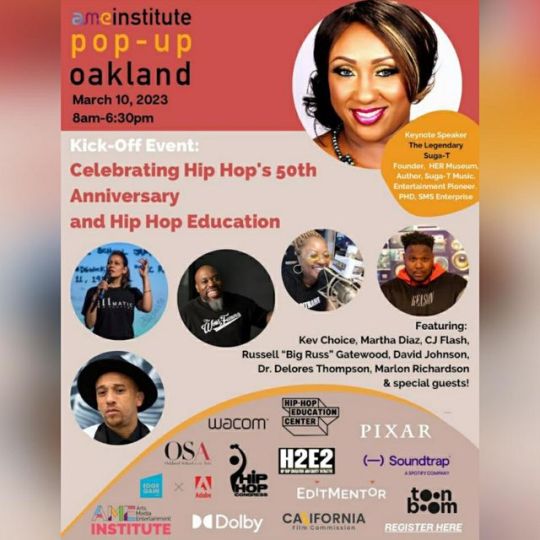
View On WordPress
#adobe#ame#ame institute#ame pop up oakland#arts media entertainment institute#Bay Area#California Department of education#department of education#Dept of Education#DLabrie#dolby#E-40#e40#H2E2#H2E2 Initiative#her museum#HHC#Hip Hop#hip hop & education#hip hop and education#Hip Hop Congress#Hip Hop Education#Hip Hop education center#hyphy#Kev choice#Martha Diaz#Mr NETW3RK#New York#oakland#oakland school for the arts
2 notes
·
View notes
Text
California Gov. Gavin Newsom (D) said on Wednesday that “education is under assault,” criticizing the banning of books across the country, efforts to suppress speech and “the othering of our students, teachers, parents.”
“I do believe education is under assault in ways that I’ve never experienced in my lifetime. I really believe that. I thought it was bad back in the day when folks were debating the merits or demerits around vouchers,” Newsom said while giving remarks at the National Forum on Education Policy after receiving the Frank Newman Award for State Innovation from the Education Commission of the States.
“You know, back in the good old days, in the ’90s, the black and white movie days, and people have different opinions about something called ‘charter schools,’” he mused. “But what’s happening now? Banning books, suppressing speech, the othering of our students, teachers, parents? It’s alarming.”
He slammed Florida, for example, after its Department of Education in April rejected dozens of math books, citing alleged references to or the inclusion of critical race theory (CRT) and social emotional learning (SEL) in them.
CRT, which is generally taught in institutions of higher education, is a decades-old theory that asserts that racism is woven into U.S. laws, institutions and history.
SEL programming aims to help students manage their emotions, develop and manage health identities and relationships and make responsible decisions, among other goals.
Newsom also slammed Texas for cutting hundreds of millions of dollars in mental health funding after Texas Gov. Greg Abbott (R) earlier this year redirected more than $200 million from the state’s Health and Human Services Commission, which oversees Texas’s mental health services, toward his border security initiative.
“But what about the whole person? What about the wellness of our kids? Everybody’s talking a good game now about mental health,” Newsom said.
“There’s one large state, Texas, where they cut mental health funding by $211 million. You know why I’m up here? Because we just expanded mental health by $4.7 billion in our public education system in the state of California.”
Newsom has been considered a possible 2024 Democratic presidential contender, though the California governor said in an interview last year that a presidential bid has “literally 100 percent never been on my radar.”
#us politics#news#the hill#2022#gov. gavin newsom#education#education reform#National Forum on Education Policy#Frank Newman Award for State Innovation#Education Commission of the States#Department of Education#crt#critical race theory#sel#social emotional learning#Health and Human Services Commission#gov. greg abbott#california#texas#book burning#book bans#freedom of speech
26 notes
·
View notes
Video
youtube
DEPARTMENT OF EDUCATION - DEMO 2022
4 notes
·
View notes
Text
The Best News of Last Month
Sorry for being not active this month as I had some health problems. I'll start posting weekly now :) Meanwhile here's some good from last month
1. Widow donates $1 billion to medical school, giving free tuition forever
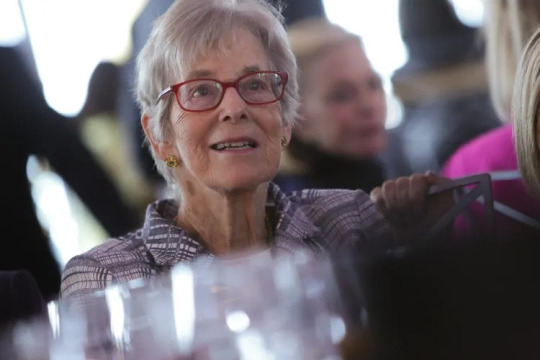
Ruth Gottesman surprised by her late husband's $1 billion in Berkshire stock, decides to donate it in full to the Albert Einstein College of Medicine in the Bronx, New York City's poorest borough. The donation is intended to cover students' tuition indefinitely, ensuring access to medical education for generations.
A video capturing students' emotional reactions to the news, cheering and crying, circulated after the announcement, highlighting the profound impact of the donation on the medical school community.
2. Electric school buses outperform diesel in extreme cold

In Colorado's West Grand School District, electric school buses outperformed their diesel counterparts, particularly in the bitterly cold temperatures of towns like Kremmling, where morning temperatures can drop below -30 degrees Fahrenheit. Despite common concerns about reduced range in extreme weather, the electric buses maintained their battery charge even in these frigid conditions, providing reliable transportation for students.
This success has been welcomed by the school district, as diesel vehicles also face challenges in starting in Colorado's harsh winter weather.
3. Christian Bale unveils plans to build 12 foster homes in California

Christian Bale has led a tour round the new village in California where he plans to build 12 foster homes, as well as two studio flats to help children transition into independent living, and a 7,000 sq ft community centre.
The actor has spearheaded the building of a unique complex of facilities with the aim of keeping siblings in the foster care system together, and ideally under the same roof.
4. Average lifespan of a person with Down syndrome has increased from 25 years in 1983 to 60 years today

Today the average lifespan of a person with Down syndrome is approximately 60 years.
As recently as 1983, the average lifespan of a person with Down syndrome was 25 years. The dramatic increase to 60 years is largely due to the end of the inhumane practice of institutionalizing people with Down syndrome.
5. Greece legalises same-sex marriage
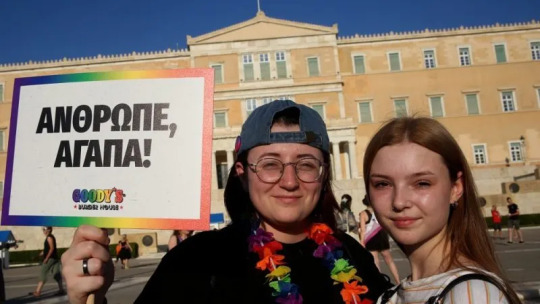
Greece has become the first Christian Orthodox-majority country to legalise same-sex marriage. Same-sex couples will now also be legally allowed to adopt children after Thursday's 176-76 vote in parliament.
Prime Minister Kyriakos Mitsotakis said the new law would "boldly abolish a serious inequality".
6. Massachusetts police K9 tracks scent for over 2 miles to find missing 12-year-old in freezing cold

A Massachusetts police K9 followed her nose to help find a 12-year-old who went missing in frigid temperatures last week, tracking the child’s scent for over two miles, authorities said.
K9 Biza, a female German shepherd, was called on to help after officers learned the child left their home at around 10:30 p.m. Wednesday and was last seen in the Pakachoag Hill area of Auburn, the Auburn Police Department said.
7. Good News for the Socially Anxious: People Like You a Lot More Than You Think They Do, New Research Confirms

The "Lake Wobegon effect" or "illusory superiority" phenomenon highlights people's tendency to overestimate their abilities, but recent research suggests that in social interactions, individuals often underestimate their likability and charm.
Studies indicate that people consistently fail to recognize signals of others' liking toward them, leading to a "liking gap" where individuals believe they are less likable than they actually are.
Techniques such as focusing more on others during conversations and genuinely expressing interest in them can help alleviate social anxiety by shifting the focus away from self-criticism. Ultimately, understanding that others may also experience similar anxieties can lead to a more relaxed and enjoyable social experience.
---
That's it for this week :)
This newsletter will always be free. If you liked this post you can support me with a small kofi donation here:
Buy me a coffee ❤️
Also don’t forget to reblog this post with your friends.
3K notes
·
View notes
Text
Things Biden and the Democrats did, this week #9
March 9-15 2024
The IRS launched its direct file pilot program. Tax payers in 12 states, Florida, New Hampshire, Nevada, South Dakota, Tennessee, Texas, Washington, Wyoming, Arizona, Massachusetts, California and New York, can now file their federal income taxes for free on-line directly with the IRS. The IRS plans on taking direct file nation wide for next year's tax season. Tax Day is April 15th so if you're in one of those states you have a month to check it out.
The Department of Education’s Office of Civil Rights opened an investigation into the death of Nex Benedict. the OCR is investigating if Benedict's school district violated his civil rights by failing to protect him from bullying. President Biden expressed support for trans and non-binary youth in the aftermath of the ruling that Benedict's death was a suicide and encouraged people to seek help in crisis
Vice President Kamala Harris became the first sitting Vice-President (or President) to visit an abortion provider. Harris' historic visit was to a Planned Parenthood clinic in St. Paul Minnesota. This is the last stop on the Vice-President's Reproductive Rights Tour that has taken her across the country highlighting the need for reproductive health care.
President Biden announced 3.3 billion dollars worth of infrastructure projects across 40 states designed to reconnect communities divided by transportation infrastructure. Communities often split decades ago by highways build in the 1960s and 70s. These splits very often affect communities of color splitting them off from the wider cities and making daily life far more difficult. These reconnection projects will help remedy decades of economic racism.
The Biden-Harris administration is taking steps to eliminate junk fees for college students. These are hidden fees students pay to get loans or special fees banks charged to students with bank accounts. Also the administration plans to eliminate automatic billing for textbooks and ban schools from pocketing leftover money on student's meal plans.
The Department of Interior announced $120 million in investments to help boost Climate Resilience in Tribal Communities. The money will support 146 projects effecting over 100 tribes. This comes on top of $440 million already spent on tribal climate resilience by the administration so far
The Department of Energy announced $750 million dollars in investment in clean hydrogen power. This will go to 52 projects across 24 states. As part of the administration's climate goals the DoE plans to bring low to zero carbon hydrogen production to 10 million metric tons by 2030, and the cost of hydrogen to $1 per kilogram of hydrogen produced by 2031.
The Department of Energy has offered a 2.3 billion dollar loan to build a lithium processing plant in Nevada. Lithium is the key component in rechargeable batteries used it electric vehicles. Currently 95% of the world's lithium comes from just 4 countries, Australia, Chile, China and Argentina. Only about 1% of the US' lithium needs are met by domestic production. When completed the processing plant in Thacker Pass Nevada will produce enough lithium for 800,000 electric vehicle batteries a year.
The Department of Transportation is making available $1.2 billion in funds to reduce decrease pollution in transportation. Available in all 50 states, DC and Puerto Rico the funds will support projects by transportation authorities to lower their carbon emissions.
The Geothermal Energy Optimization Act was introduced in the US Senate. If passed the act will streamline the permitting process and help expand geothermal projects on public lands. This totally green energy currently accounts for just 0.4% of the US' engird usage but the Department of Energy estimates the potential geothermal energy supply is large enough to power the entire U.S. five times over.
The Justice for Breonna Taylor Act was introduced in the Senate banning No Knock Warrants nationwide
A bill was introduced in the House requiring the US Postal Service to cover the costs of any laid fees on bills the USPS failed to deliver on time
The Senate Confirmed 3 more Biden nominees to be life time federal Judges, Jasmine Yoon the first Asian-America federal judge in Virginia, Sunil Harjani in Illinois, and Melissa DuBose the first LGBTQ and first person of color to serve as a federal judge in Rhode Island. This brings the total number of Biden judges to 185
#Thanks Biden#Joe Biden#Democrats#politics#US politics#good news#nex benedict#abortion#taxes#climate change#climate action#tribal communities#lithium#electronic cars#trans rights#trans solidarity#judges
357 notes
·
View notes
Text

Diagrams from, Janet Abbott, Learn to Fold - Fold to Learn (California State Department of Education, 1970).
copy from the long dormant toysandtechniques blogspot
493 notes
·
View notes
Note
Hi!! I hope it's okay to ask, which university are you/were you attending? I want to study animation in university but i have no idea which one to choose, so can you please tell me about yours?👉👈
I go to CSUF! It’s definitely one of the cheapest places to get a degree in animation in California, if not the US.
Only a handful of the California State schools offer animation, and most of the ones that do are 3D only, and I wanted to learn 2D.
SJSU has a good 2D anim program, and they’re the only state school in the bay area that does, BUT last I checked you need something like a 3.9 GPA to get in?????? like HELLO these are animation students. who are you fooling
the other schools I considered were CSULB and CSUN.
CSULB has a strong animation program! They have the guy that literally created the worldwide 24 Hour Animation Challenge. However, they required ONE extra art history class that none of the other CSUs needed, and I didn’t have it, and I wasn’t about to prolong transferring a whole other semester just to take it. (It was prehistoric art history, I think, which I admit sounds cool as fuck)
The reason I chose CSUF, beyond liking their curriculum better than CSUN, was because I heard about the Pencil Mileage Club. It’s the largest student-run animation club in Southern California. I’d argue that networking is almost more important than your actual skill. I’ll admit, the faculty is probably not doing as much for the students as other schools, but PMC more than makes up for it. I’ve made all my friends (and girlfriend teehee) through this club. I was president of my Art Club at my community college, so it was important to me to be part of PMC’s council. I’m now an event coordinator and so I help organize and run events and studio tours and guest speakers! :)) Clubs and extracurriculars look fantastic on resumes, so wherever you go, look into what’s available.
Things I should note: when you start at CSUF, whether as a freshman or through transferring, you will not be an animation major yet. You have to do the portfolio review first, and you can’t have any of the prerequisite classes in-progress when you apply. The portfolio requirement is only a few years old, too, and therefore it’s not nearly as competitive as, say… calarts or sheridan. I often say, students make the program better, not the other way around. the higher the level of students that apply, the higher the overall education quality will need to be to match that. Though this does mean that the higher quality a program is, the more people will be excluded, unfortunately.
CSUF’s aniamtion program itself is…. a little silly. You take storyboarding and character design after doing your short film ? for some reason? The new department head started at the school the same semester I did, and she’s definitely trying to make it better. She held a screening of the production classes’ finished films, and she told me she plans to have the curriculum restructured by 2025 (after I graduate, lol).
I’ll also mention that the art buildings are in the process of getting demolished and rebuilt. The first wave of new buildings won’t be done until the end of this year, and once that’s finished, they’ll tear down the remaining two buildings and start remodeling those. For now, we do a lot of our classes in the modular buildings jdhshfjs 🫡
We also have a mated pair of gay ducks that come every spring. Their names are Pebble and Rock. They are beloved by the art students.
And really, you don’t NEED a degree in animation to get into the industry. There are SO many online resources out there, a lot that are free, that can give you just as good of an education (in fact, several of my professors’ lectures have just been playing youtube videos and pulling up articles). BUT your classmates WILL be your future coworkers. If you’re not establishing relationships with people in some way on your own, you definitely need to make that bigger priority. After all, you won’t be working by yourself when you’re in the industry.
edit: oh I forgot to say that all the california state schools are striking the first week of the semester. so uh. there’s that
118 notes
·
View notes
Text
by Richard Goldberg
Anti-Semitism is spreading in K–12 school districts. Even in primary and secondary education, Jews are often viewed as privileged whites and oppressors, with Israel branded as an egregious example of “settler colonialism” and oppression of “indigenous people.” “Liberated ethnic studies” curricula, like the one mandated by California, have created a distinct variant of critical theory aimed at Jews for being Zionist colonial oppressors.
Teachers’ unions are the leading purveyors of this approach. Two years ago, the United Educators of San Francisco adopted a resolution calling for a boycott of Israel. The Chicago Teachers Union instigated pro-Hamas demonstrations in the Windy City after October 7. The union persuaded Chicago mayor Brandon Johnson (a former CTU lobbyist) to condemn Israel in the city council, and it organized a student and faculty “walkout” to show solidarity with Hamas—a city-authorized event that left Jewish students and teachers feeling intimidated. In suburban Seattle, kids as young as seven were recently encouraged to condemn Israel and join in anti-Semitic chants. Oakland Unified School District faces a federal investigation after 30 Jewish families removed their kids from school due to rampant anti-Semitism. And at a high school in New York City, hundreds of students hunted down a female teacher they saw on social media holding a sign supporting Israel.
Marxist ideology is the primary culprit influencing this mind-set, but not the only one. Qatar, a tiny Persian Gulf country that supports Hamas, is funding anti-Semitic “scholarship” not only in American universities but also in K–12 schools. Qatar Foundation International gave $1 million to the New York City Department of Education between 2019 and 2022 for a program featuring a map of the Middle East that erases the Jewish state. The same story played out at a public charter school in Irving, Texas. What other districts in the country might be taking money directly or indirectly from a chief Hamas sponsor? Brown University’s Choices Program, used by more than 1 million high school students nationwide, exhibits a clear anti-Israel bias. According to Brown, the Qataris “purchased and distributed a selection of existing Choices curriculum units to 75 teachers whose districts didn’t have funding to buy them.”
Tools to fight back, however, are available. Governors and state legislatures can begin by blocking “ethnic studies” from the K–12 curriculum and by imposing new teacher-certification requirements. To curb foreign meddling, states should ban school funding or in-kind donations from entities connected with countries that harbor U.S.-designated terrorist organizations. School districts and state boards of education should use the International Holocaust Remembrance Alliance’s working definition of anti-Semitism to root out conduct meeting its standard. Several groups sued the Santa Ana, California, school district in state court for failing to notify parents before approving ethnic studies courses that contain anti-Jewish bias and for harassing Jewish parents at school board meetings.
At the federal level, parents could file formal complaints with the Department of Education for discrimination under Title VI of the Civil Rights Act. Such complaints are increasingly common against colleges and universities, but any school that receives federal funding must comply with Title VI. The House Committee on Education and the Workforce should consider holding a hearing on anti-Semitism in K–12 schools, putting the national spotlight on anti-Jewish administrators and school board leaders.
Local, state, and federal officials have played meaningful roles in fighting back against critical race theory in the classroom. They need to fight equally hard to stop anti-Semitism masquerading as Middle East or ethnic studies.
64 notes
·
View notes
Text
Some tangible Black queer history for you!
In case you needed any more proof that we've always been here - this amazing collection is courtesy of the Stonewall National Musuem and Archive!
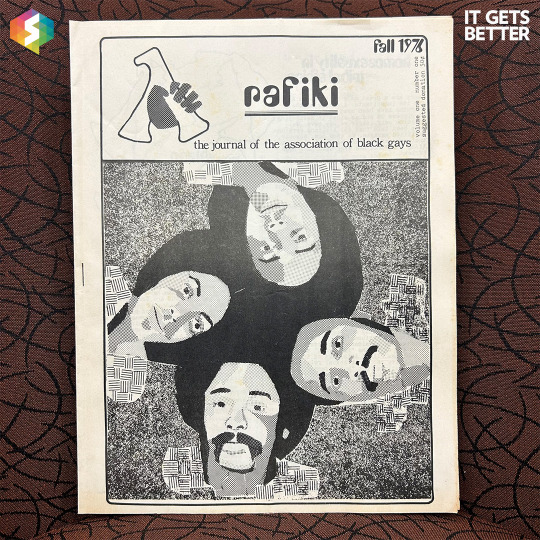
Rafiki: The Journal of the Association of Black Gays, Vol. 1 #1 (Fall 1976)
"Rafiki was a quarterly publication from the Association of Black Gays (ABG), a Los Angeles, California gay activist group that organized through education, political engagement, and grassroots activism to
improve the conditions for Los Angeles’s Black gays and lesbians.
According to the journal, the title Rafiki was chosen because it means “friend” in Swahili and “that’s what [ABG] hope to be for you.” This first issue includes an article on the history of ABG and the fact that Black gays and lesbians have been largely excluded from the political, social, and economic advances of the gay community.
Included in this issue are articles such as “Homosexuality in Tribal Africa” and “Disco Discontent” (an open letter to the owner of Studio One, Scott Forbes), as well as poetry by Steven Corbin and Frances Andrews, and book reviews. It even contains an ad for the famous Catch One Club owned by Jewel Williams, which is still
operating today!"

I Am Your Sister: Black Women Organizing Across Sexualities by Audre Lorde (Kitchen Table: Women of Color Press, 1985; from the Freedom Organizing Series)
You can read this one here!
"This small twelve-page publication derives from a speech Audre Lorde gave at the Women’s Center of Medgar Evers College in New York City regarding the exclusion of Lesbians in the feminist movement and how Lorde’s identity as both a Black woman and lesbian are inextricably linked.
Primarily, heterosexism and homophobia are major issues Lorde states are “two grave barriers to organizing among Black women.” Lorde ends the essay with the statement: “I am a Black Lesbian, and I am your sister.”
Her emphasis on the duality of this identity stems from a 1960s poster that said “He’s not black, he’s my brother!,” which Lorde states infuriated her because “it implied that the two were mutually
exclusive.”
Kitchen Table: Women of Color Press was founded by Barbara Smith—another Black Lesbian feminist—and Audre Lorde in 1980 to create a publishing apparatus for women of color who at the time did not have control over how they were published except through the white-dominated outlets."

Flawless! The Life & Times of T.B.D.J. AKA Tiffani Inc. AKA Mrs. … (Manuscript) by Tiffany Bowerman (July 2007, A&E Publishers)
This autobiographical manuscript traces the life of Tiffany Bowerman aka Tiffany B.D. Johnson (b. 1959), who states that she “was the first African-American Transsexual to have state issued birth certificate reissued [1990]… was the first to legally marry three different active duty military men… [and] first… to found their own Christian Denomination… The Agape-Ecumenical Christian Denomination.”
Further, she states “I have tried to put together something striking and original[,] a journey from childhood to self aware adult. A life that was and is with all regrets included.”
This manuscript is a preliminary copy of a rough draft, and contains various memoirs, photographs, legal documents, and ephemera.
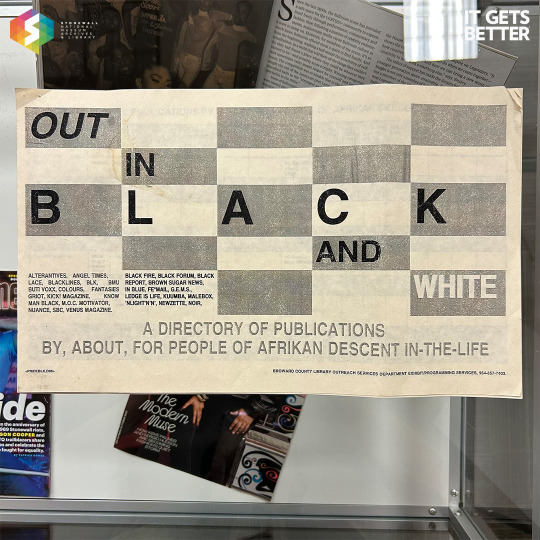
Out in Black and White: A Directory of Publications By, About, For People of Afrikan Descent In-The-Life by the Broward County Library Outreach Services Department Exhibit/Programming Services with direction by Eric Jon Rawlins (January, 1996)
Out in Black and White is a directory of various serial publications (magazines, newsletters, journals, etc.) throughout the United States that are focused on the Black LGBTQ experience. According to the directory, “[t]his project was inspired by the atmosphere of strength, oneness and productivity created by the Million Man March [on October 16,] 1995.”
The Million Man March was a political demonstration that took place at the National Mall in Washington, D.C. with the purpose of encouraging involvement in the improvement of the conditions of African Americans. Eric Jon Rawlins was a Broward County, Florida librarian who at one time was also the second vice president of the NAACP Fort Lauderdale branch in the late 1980s.
Currently, the Eric Jon Rawlins Collection consisting of personal and professional papers, as well as his 6,000 vinyl record album collection, are housed at the African American Research Library and Cultural Center Special Collections in Broward County, FL.
#it gets better#black history month#bhm#black trans lives matter#lgbtqia#queer history#lgbtq history#black history#queer archive#queer lit#studyblr
103 notes
·
View notes
Text
Rowaida Abdelaziz at HuffPost:
Earlier this month, the University of Southern California announced that Asna Tabassum would be the Class of 2024′s valedictorian, with a 3.98 GPA and in recognition of her community service and leadership skills. She is graduating with a major in biomedical engineering and a minor in resistance to genocide.
But on Monday, USC canceled the speech.
In an announcement dated Monday, Provost Andrew Guzman said the “intensity of feelings, fueled by both social media and the ongoing conflict in the Middle East” has “created substantial risks relating to security and disruption at commencement.”
“After careful consideration, we have decided that our student valedictorian will not deliver a speech at commencement. While this is disappointing, tradition must give way to safety,” he wrote. “This decision has nothing to do with freedom of speech. There is no free-speech entitlement to speak at a commencement. The issue here is how best to maintain campus security and safety, period.”
The school did not elaborate further. Reached for comment, the provost’s office directed HuffPost to Guzman’s statement.
Tabassum, in an interview with HuffPost, questioned the university’s reasoning and told HuffPost she felt disappointed and let down by USC.
“I am surprised that my own university – my home for four years – has abandoned me,” she said.
In a statement published on Monday, Tabassum said that she was not aware of any specific threats against her or the university, and that during a meeting last Sunday, administrators told her that “the University had the resources to take appropriate safety measures for my valedictory speech, but that they would not be doing so since increased security protections is not what the University wants to ’present as an image.’”
“Security and safety is also my concern. That’s consistent with my commitment to human equality and human rights. I don’t think that they’re mutually exclusive at all,” Tabassum told HuffPost. She noted that notable figures including former President Barack Obama, rap star Travis Scott and right-wing speaker Milo Yiannopoulos have all been able to visit campus grounds.
[...]
A slew of universities have struggled to address students’ protests of the bombing campaign by Israeli forces in Gaza that has killed more than 33,000. In the last few months, schools have dealt with rising cases of antisemitism and Islamophobia, the deactivation of student-activist groups, suspension of staff, cases of doxxing and harassment and even reports of physical violence.
This week, Columbia University’s president is set to testify at a congressional hearing about campus safety, four months after a similar hearing resulted in the resignation of two Ivy League presidents. And the Department of Education launched a series of investigations last November into several universities where students have reported antisemitic or Islamophobic incidents.
Tabassum said she was denied a chance to let others see someone like her give a high-profile speech ― a South Asian hijab-wearing Muslim, someone “representative of communities and of the masses of people who never saw the institution made for them,” she told HuffPost. “I wanted to offer the hope that ... we can succeed [at] institutions like USC.”
[...]
According to USC’s Annenberg Media, some students and alumni said Tabassum’s social media activity ― which includes a link to a pro-Palestinian page ― was antisemitic. Guzman, however, wrote that this decision was made “based on various criteria ― which did not include social media presence.”
Since the university’s decision, Tabassum said she’s been overwhelmed by messages of both support and hate. People from her elementary school who she hasn’t spoken to in a decade reached out. Others have taken to Instagram to speculate about her ethnic background and her political views, and to applauded the university’s decision to revoke her invitation.
The USC's asinine decision rescinding Valedictorian Asna Tabassum's chance to make a speech is craven cowardice to Islamophobia and Israel Apartheid apologia all because of her support for Palestine.
See Also:
The Guardian: Backlash as USC cancels valedictorian’s speech over support for Palestine
#USC#University of Southern California#Asna Tabassum#Palestine#Islamophobia#Israel/Hamas War#Ceasefire NOW Protests#Israel/Hamas War Protests#Israel Apartheid#Cancel Culture
52 notes
·
View notes
Photo

Depending on who you talked to, James Jackson was either a con man, a genius, a degenerate gambler, a reincarnated shaman from ages past, or some combination of all four. “Jim”, as his friends and detractors called him, was a strange man. He was a self-educated thinker who was absolutely convinced that he was possessed of talents that approached the supernatural.
He may have been right: in the history of American enterprise there was no one quite like Jim Jackson. His overall demeanor and presentation to all who interacted with him was that of a self-styled cowboy; he wore ostrich-leather boots, always had a Marlboro cigarette in his mouth, and owned a ten gallon hat in every color in the catalog, and spoke with a drawl so thick that he could easily be mistaken for a man out of time. This man, who came to embody every myth of the western oilman and whose exploits would someday captivate a nation, had not stepped foot in Texas until his twentieth birthday. He never made a dime from oil.
Jim was born in Boston on July 16th, 1945 at the exact instant that the first atomic bomb was detonated two thousand miles away in New Mexico. He was the youngest of four children to Walter and Evelyn Jackson; Evelyn was a classically-trained stage actress who came from old money tied up in real estate in the northeast. Walter was a prolific and brilliant chemist who directed a research group for Bell Telephone Laboratories. During the war, Walter’s team was instrumental in developing the membranes necessary for the gas-diffusion method of enriching uranium for the Manhattan Project. Walter moved his family from Boston to San Jose, California in 1949 to partner with one of his former colleagues in founding a new applied science company. This new venture, Allied Micromaterials Corporation, would become one of the pioneering institutions in the development of semiconductors and later transistors. Contacts Walter had maintained in the defense department led to Allied receiving a contract to manufacture guidance systems for a new range of ICBM missiles, and by the middle of the 1950s, Walter was a very wealthy man.
As a boy, Jim was bright but had no patience for school. On several occasions he was found cutting class to wander along a creek that ran through the family’s estate. The land had been an apricot orchard before being purchased by his father, and a young Jim spent every spare minute he could find playing cowboy in the pastoral grove of trees. His patient mother indulged his fantasies and sent him to dude ranches and paid for horse riding lessons in the hopes it might instill a sense of discipline. By Jim’s sixteenth birthday he was showing signs of restlessness in the rapidly-urbanizing Californian environment, and entered into frequent arguments with his exasperated father. When he told Walter that he had no interest in attending college, and instead mentioned the then-escalating conflict in Vietnam, his father shouted him down. Angry but determined, a seventeen year old Jim walked to an army recruitment station the very next morning. It was of no use, however; through Walter’s many ties to the U.S. defense industry, it was essentially guaranteed that Jim would never see combat. For the young man who yearned to see the world and longed for an adventure to break the monotony of his sheltered upbringing, this was the final straw.
On a spring day in 1962, James Jackson packed a small bag and left home. From San Jose he took a train to Carson City, Nevada with the intent of finding work at one of the horse ranches from his childhood. When he arrived, a new subdivision had taken its place, with any traces of the ranches long gone. For two months he washed dishes in a casino buffet in Reno to pay for accrued gambling debts. From Nevada he hitchhiked to Idaho where he cut onions for 80¢ a day until the winter season forced him to move on. For three years he stumbled from job to job, lumberjacking in Washington state, fitting irrigation pipe in Arizona, welding in Alaska, mining Molybdenum in Colorado, and eventually working as a roughneck in an oilfield outside of Odessa, Texas. These three years had hardened young Jim and for the first time he felt at home among the wildcatters and oilmen in the dust and sun of west Texas. The challenge of the work invigorated him. The harsh conditions of the desert inspired him. The boom-bust cycle of the petroleum industry, however, did little to help secure the human needs of food and shelter. The men who made the real money on the drilling sites, Jim had noticed, were the geologists; those who only found the oil and didn’t stick around to do the hard work of pulling it out of the ground. Jim was charismatic, and it wasn’t long before he found work as an assistant for a local surveying office and began to learn the fine art of finding things underground. (edited)
He was almost ready to settle down when he received a call from home: His father had suffered an intracranial aneurysm and had died before emergency medical treatment could be administered. For the first time in years, he went home. In the days after Walters funeral, Jim was forced to confront his future. Jim was twenty, with little occupational prospects, but now had a twenty-five thousand dollar inheritance; enough in 1965 to get into nearly any business he wanted. He knew he still didn’t have the patience for college, and he had already figuratively “gone west.” Out of either a feeling of guilt, or a desire to not cause any further trouble to his family in California, he returned to Texas with the goal of finally striking out on his own.
By 1973, James Jackson was a man who, at least on the surface, betrayed no insecurities about his expertise. He exuded confidence and, after a few lucky breaks locating petroleum where none was thought to have existed, was billed as a “guru of the underground”. A small office was leased in Midland, a clerk and eventually a geologist, a few engineers and surveyors were hired. For a short time it was a mundane but generally honest living. What he lacked in experience as the chief of the small firm he more than made up for in the energy and zeal he brought to every job he undertook. He detested office work and would personally show up to every site, rain or shine, with the enthusiasm and showmanship of a circus ringmaster.
The job for Dale Whitmer was no exception.
1K notes
·
View notes
Text
A brief summary of how Education fails Boys
I saw people sincerely questioning and minimizing the current struggles boys face in education.
So, I wanted to collect some relevant information, with sources. All of these are from the past couple of years, from 2021 onward.
Girls have more difficulty accessing education and are more likely than boys to be out of school at primary level. However, boys are at greater risk of repeating grades, failing to progress and complete their education, and not learning while in school. Globally, 128 million boys are out of school. That’s more than half of the global out-of-school youth population and more than the 122 million girls who are also out of school.
The Leave no child behind: Global report on boys’ disengagement from education shows that boys are increasingly left behind in education. They are at greater risk of repeating grades, failing to progress and complete their education, and not learning while in school. While previously boys’ disengagement and dropout were concerns mainly in high-income countries, several low- and middle-income countries have seen a reversal in gender gaps, with boys now lagging behind girls in enrolment, completion and learning outcomes. Boys are more likely than girls to repeat primary grades in 130 countries, and more likely to not have an upper secondary education in 73 countries. At tertiary level, globally only 88 men are enrolled for every 100 women.
In 1970, women only made up 42 percent of the college population. Today, the roles have essentially reversed. The U.S. Department of Education estimates men to make up 43 percent of enrolled individuals in college. And this crisis impacts minority populations even more: only 36 percent of Black and 40 percent of Hispanic bachelor degree recipients are male.
This is not an issue of colleges neglecting to admit men at an equal rate. Rather, colleges are receiving fewer applications from men than women. In 2010, only 44 percent of college applications were from men and that number has been steadily declining since. The decrease in male applicants is a sign that men are discouraged from pursuing higher education at a disproportionately high rate.
These statistics point to a larger, systemic problem. The American education system perpetuates a series of gender norms that cause significant harm to children; boys are impacted by these expectations in a way that tends to be overlooked. The stereotype that boys have a higher propensity to misbehave has led to the over-punishment of boys in the classroom.
Boys are facing key challenges in school. Inside the effort to support their success
An APA task force is spotlighting the specific issues and recommending evidence-based ways to enact swift change
At school, by almost every metric, boys of all ages are doing worse than girls. They are disciplined and diagnosed with learning disabilities at higher rates, their grades and test scores are lower, and they’re less likely to graduate from high school (Owens, J., Sociology of Education, Vol. 89, No. 3, 2016; Voyer, D., & Voyer, S. D., Psychological Bulletin, Vol. 140, No. 4, 2014; “The unreported gender gap in high school graduation rates,” Brookings, 2021). These disparities persist at the university level, where female enrollment now outpaces male enrollment by 16% (Undergraduate Enrollment, National Center for Education Statistics, 2022).
“The gap between boys and girls is apparent from very early on,” said developmental psychologist Ioakim Boutakidis, PhD, a professor of child and adolescent studies at California State University, Fullerton. “The disparities not only exist across the board—from kindergarten all the way to college—but they are growing over time.”
For boys of color, that gap is even larger. They face suspension and expulsion from school at almost five times the rate of their White male classmates and are even less likely to finish high school or college (“Exploring Boys’ (Mis)Behavior,” Society for the Psychological Study of Men and Masculinities, 2022 [PDF, 261KB]).
The implications of these disparities are huge. Doing poorly at school is strongly associated with major challenges later in life, including addiction, mental and physical health problems, and involvement with the criminal justice system—problems that also have ripple effects on society at large. In the United States, getting at least a college degree may be the one remaining, relatively stable ticket to a decent life, Boutakidis said.
In a recent New York Times essay, “It’s Become Increasingly Hard for Them to Feel Good About Themselves,” Thomas Edsall reviews a variety of research studies highlighting the plight of young men in the United States. As a front-line educator who has worked in boys’ schools for 30 years and served as the head of a boys’ school for the past 20 years, I’ve been an unhappy witness to this dilemma.
Data supports the claim that boys are falling behind, and dramatically so. For example, there is a growing gender gap in high school graduation rates. According to the Brooking Institution, in 2018, about 88% of girls graduated on time, compared with 82% of boys.
For college enrollment, the gender gap is even more striking, with men now trailing women in higher education at record levels. Last year, women made up 60% of college students while men accounted for only 40%, according to statistics from the National Student Clearinghouse. College enrollment in the United States has declined by 1.5 million students over the past five years, with men accounting for 71% of that drop.
45 notes
·
View notes
Text
The Best News of Last Week
1. A branch of the flu family tree has died and won't be included in future US vaccines
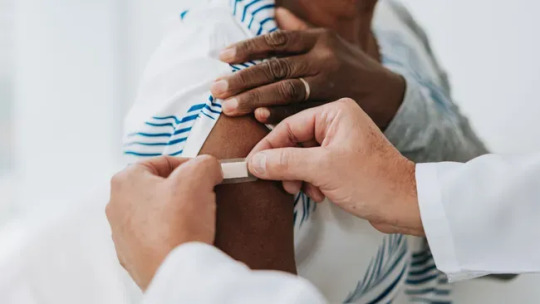
A type of flu virus that used to sicken people every year hasn't been spotted anywhere on Earth since March 2020. As such, experts have advised that the apparently extinct viruses be removed from next year's flu vaccines.
The now-extinct viruses were a branch of the influenza B family tree known as the Yamagata lineage. Scientists first reported the apparent disappearance of Yamagata viruses in 2021.
2. Hospitals must obtain written consent for pelvic and similar exams, the federal government says

Hospitals must obtain written informed consent from patients before subjecting them to pelvic exams and exams of other sensitive areas — especially if an exam will be done while the patient is unconscious, the federal government said Monday.
New guidance from the U.S. Department of Health and Human Services now requires consent for breast, pelvic, prostate and rectal exams for “educational and training purposes” performed by medical students, nurse practitioners or physician assistants.
3. Germany approves new law that will allow adults to carry up to 25 grams of cannabis for their own consumption and store up to 50 grams at home.

Germany's upper house, the Bundesrat, cleared the way to partially legalize cannabis on Friday. Adults aged 18 and over will be allowed to carry up to 25 grams of cannabis for their own consumption.
4. Tick-killing pill shows promising results in human trial | Should it pan out, the pill would be a new weapon against Lyme disease.

Tarsus Pharmaceuticals is developing a pill for humans that could provide protection against the tick-borne disease for several weeks at a time. In February, the Irvine, California–based biotech company announced results from a small, early-stage trial showing that 24 hours after taking the drug, it can kill ticks on people, with the effects lasting for up to 30 days.
5. Thailand moves to legalise same-sex marriage

Thailand has taken a historic step closer to marriage equality after the lower house passed a bill giving legal recognition to same-sex marriage.
It still needs approval from the Senate and royal endorsement to become law but it is widely expected to happen by the end of 2024, making Thailand the only South East Asian country to recognise same-sex unions.
6. French Revolution: Cyclists Now Outnumber Motorists In Paris

Official measurements have found that Paris is rapidly becoming a city of transportation cyclists. In the suburbs, where public transit is less dense, transport by car was found to be the main form of mobility. But for journeys from the outskirts of Paris to the center, the number of cyclists now far exceeds the number of motorists, a huge change from just five years ago.
7. 'Miracle' operation reverses blindness in three-year-old girl giving her 'promising' future

A three year old with a genetic condition that causes blindness is doing incredibly well after unique pioneering operation to restore her sight.
The UK is the only country performing keyhole eye surgery to inject healthy copies of a gene into sufferers’ eyes. It is being used to reverse blindness in children born with a rare condition which means they can only distinguish between light and dark. And it has given little Khadijah Chaudhry, born with Leber congenital amaurosis-4, a chance at seeing properly again.
---
That's it for this week :)
This newsletter will always be free. If you liked this post you can support me with a small kofi donation here:
Buy me a coffee ❤️
Also don’t forget to reblog this post with your friends.
821 notes
·
View notes
Text
It would take Diane Joyce nearly ten years of battles to become the first female skilled crafts worker ever in Santa Clara County history. It would take another seven years of court litigation, pursued all the way to the U.S. Supreme Court, before she could actually start work. And then, the real fight would begin.
For blue-collar women, there was no honeymoon period on the job; the backlash began the first day they reported to work—and only intensified as the Reagan economy put more than a million blue-collar men out of work, reduced wages, and spread mounting fear. While the white-collar world seemed capable of absorbing countless lawyers and bankers in the 80s, the trades and crafts had no room for expansion. "Women are far more economically threatening in blue-collar work, because there are a finite number of jobs from which to choose," Mary Ellen Boyd, executive director of Non-Traditional Employment for Women, observes. "An MBA can do anything. But a plumber is only a plumber." While women never represented more than a few percentage points of the blue-collar work force, in this powder-keg situation it only took a few female faces to trigger a violent explosion.
Diane Joyce arrived in California in 1970, a thirty-three-year-old widow with four children, born and raised in Chicago. Her father was a tool-and-die maker, her mother a returned-goods clerk at a Walgreen's warehouse. At eighteen, she married Donald Joyce, a tool-and-die maker's apprentice at her father's plant. Fifteen years later, after working knee-deep in PCBs for years, he died suddenly of a rare form of liver cancer.
After her husband's death, Joyce taught herself to drive, packed her children in a 1966 Chrysler station wagon and headed west to San Jose, California, where a lone relative lived. Joyce was an experienced bookkeeper and she soon found work as a clerk in the county Office of Education, at $506 a month. A year later, she heard that the county's transportation department had a senior account clerk job vacant that paid $50 more a month. She applied in March 1972.
"You know, we wanted a man," the interviewer told her as soon as she walked through the door. But the account clerk jobs had all taken a pay cut recently, and sixteen women and no men had applied for the job. So he sent her on to the second interview. "This guy was a little politer," Joyce recalls. "First, he said, 'Nice day, isn't it?' before he tells me, 'You know, we wanted a man.' I wanted to say, 'Yeah, and where's my man? I am the man in my house.' But I'm sitting there with four kids to feed and all I can see is dollar signs, so I kept my mouth shut."
She got the job. Three months later, Joyce saw a posting for a "road maintenance man." An eighth-grade education and one year's work experience was all that was required, and the pay was $723 a month. Her current job required a high-school education, bookkeeping skills, and four years' experience— and paid $150 less a month. "I saw that flier and I said, ‘Oh wow, I can do that.’ Everyone in the office laughed. They thought it was a riot. . . . I let it drop."
But later that same year, every county worker got a 2 to 5 percent raise except for the 70 female account clerks. "Oh now, what do you girls need a raise for?" the director of personnel told Joyce and some other women who went before the board of supervisors to object. "All you'd do is spend the money on trips to Europe." Joyce was shocked. "Every account clerk I knew was supporting a family through death or divorce. I'd never seen Mexico, let alone Europe." Joyce decided to apply for the next better-paying "male" job that opened. In the meantime, she became active in the union; a skillful writer and one of the best-educated representatives there, Joyce wound up composing the safety language in the master contract and negotiating what became the most powerful county agreement protecting seniority rights.
In 1974, a road dispatcher retired, and both Joyce and a man named Paul Johnson, a former oil-fields roustabout, applied for the post. The supervisors told Joyce she needed to work on the road crew first and handed back her application. Johnson didn't have any road crew experience either, but his application was accepted. In the end, the job went to another man.
Joyce set out to get road crew experience. As she was filling out her application for the next road crew job that opened, in 1975, her supervisor walked in, asked what she was doing, and turned red. "You're taking a man's job away!" he shouted. Joyce sat silently for a minute, thinking. Then she said, "No, I'm not. Because a man can sit right here where I'm sitting."
In the evenings, she took courses in road maintenance and truck and light equipment operation. She came in third out of 87 applicants on the job test; there were ten openings on the road crew, and she got one of them.
For the next four years, Joyce carried tar pots on her shoulder, pulled trash from the median strip, and maneuvered trucks up the mountains to clear mud slides. "Working outdoors was great," she says. "You know, women pay fifty dollars a month to join a health club, and here I was getting paid to get in shape." The road men didn't exactly welcome her arrival. When they trained her to drive the bobtail trucks, she says, they kept changing instructions; one gave her driving tips that nearly blew up the engine. Her supervisor wouldn't issue her a pair of coveralls; she had to file a formal grievance to get them. In the yard, the men kept the ladies' room locked, and on the road they wouldn't stop to let her use the bathroom. "You wanted a man's job, you learn to pee like a man," her supervisor told her.
Obscene graffiti about Joyce appeared on the sides of trucks. Men threw darts at union notices she posted on the bulletin board. One day, the stockroom storekeeper, Tony Laramie, who says later he liked to call her "the piglet," called a general meeting in the depot's Ready Room. "I hate the day you came here," Laramie started screaming at Joyce as the other men looked on, many nodding. "We don't want you here. You don't belong here. Why don't you go the hell away?"
Joyce's experience was typical of the forthright and often violent backlash within the blue-collar work force, an assault undisguised by decorous homages to women's "difference." At a construction site in New York, for example, where only a few female hard-hats had found work, the men took a woman's work boots and hacked them into bits. Another woman was injured by a male co-worker; he hit her on the head with a two-by-four. In Santa Clara County, where Joyce worked, the county's equal opportunity office files were stuffed with reports of ostracism, hazing, sexual harassment, threats, verbal and physical abuse. "It's pervasive in some of the shops," says John Longabaugh, the county's equal employment officer at the time. "They mess up their tools, leave pornography on their desks. Safety equipment is made difficult to get, or unavailable." A maintenance worker greeted the first woman in his department with these words: "I know someone who would break your arm or leg for a price." Another new woman was ordered to clean a transit bus by her supervisor—only to find when she climbed aboard that the men had left a little gift for her: feces smeared across the seats.
In 1980, another dispatcher job opened up. Joyce and Johnson both applied. They both got similarly high scores on the written exam. Joyce now had four years' experience on the road crew; Paul Johnson only had a year and a half. The three interviewers, one of whom later referred to Joyce in court as "rabble-rousing" and "not a lady," gave the job to Johnson. Joyce decided to complain to the county athrmative action office.
The decision fell to James Graebner, the new director of the transportation department, an engineer who believed that it was about time the county hired its first woman for its 238 skilled-crafts jobs. Graebner confronted the roads director, Ron Shields. "What's wrong with the woman?" Graebner asked. “I hate her," Shields said, according to other people in the room. "I just said I thought Johnson was more qualified," is how Shields remembers it. "She didn't have the proficiency with heavy equipment." Neither, of course, did Johnson. Not that it was relevant anyway: dispatch is an office job that doesn't require lifting anything heavier than a microphone.
Graebner told Shields he was being overruled; Joyce had the job. Later that day, Joyce recalls, her supervisor called her into the conference room. "Well, you got the job," he told her. "But you're not qualified." Johnson, meanwhile, sat by the phone, dialing up the chain of command. "I felt like tearing something up," he recalls later. He demanded a meeting with the affirmative action office. "The affirmative action man walks in," Johnson says, "and he's this big black guy. He can't tell me anything. He brings in this minority who can barely speak English . . . I told them, 'You haven't heard the last of me.'" Within days, he had hired a lawyer and set his reverse discrimination suit in motion, contending that the county had given the job to a "less qualified" woman.
In 1987, the Supreme Court ruled against Johnson. The decision was hailed by women's and civil rights groups. But victory in Washington was not the same as triumph in the transportation yard. For Joyce and the road men, the backlash was just warming up. "Something like this is going to hurt me one day," Gerald Pourroy, a foreman in Joyce's office, says of the court's ruling, his voice low and bitter. He stares at the concrete wall above his desk. "I look down the tracks and I see the train coming toward me."
The day after the Supreme Court decision, a woman in the county office sent Joyce a congratulatory bouquet, two dozen carnations. Joyce arranged the flowers in a vase on her desk. The next day they were gone. She found them finally, crushed in a garbage bin. A road foreman told her, "I drop-kicked them across the yard."
-Susan Faludi, Backlash: the Undeclared War Against American Women
#susan faludi#female oppression#male entitlement#male violence#blue collar#women’s work#pay gap#sexism#misogyny#womens history#us history#amerika
85 notes
·
View notes
Text
Interview with Jonathan Bailey and Matt Bomer from GQ Hype

Filled with cozy, Hemingwayesque signifiers of midcentury masculinity (think: taxidermy and artfully-tattered boxing gloves), the restaurant seemed perfect for a breezy, late-autumn hang in the West Village.
But there’s one problem: Matt Bomer and Jonathan Bailey have burgers on their minds. And while this place boasts a surplus of dead animals nailed to the wall, it somehow only serves snacks and salads in the afternoon. And as Bomer points out, Corner Bistro—a pub that, in his opinion, serves some of the best burgers in town—is just a six-minute walk away.
The British-born Bailey—who, in his black sweater, floppy beanie and overstuffed backpack, looks more like a backpacker who just rolled out of his hostel rather than one of the streaming era’s top heartthrobs—waxes rhapsodic about In-N-Out, the California burger institution, which he recently tried for the first time.
He asks the suave, Old Hollywood-handsome Bomer, who spends most of his time in L.A. with his husband and three teenage sons, where In-N-Out falls on his personal burger index. “Our boys are really good judges of burgers,” Bomer says, and for them, In-N-Out is up there—but so is the burger at Corner Bistro. And how can we send Bailey—the Viscount of Bridgerton himself—back to London without tasting New York’s best?
Our location, midway between Stonewall Inn and Julius, two of New York’s most historic gay bars, is apt. The project we’re here to talk about—the epic new Showtime series Fellow Travelers, in which the pair star—tips its hat to the legendary 1969 riots that happened in Stonewall, but goes even further, telling the story of gay liberation in the second half of the twentieth century.
Part epic love story, part political thriller, Fellow Travelers begins in 1950s Washington, D.C., with an illicit affair between the strapping Hawkins “Hawk” Fuller (Bomer), a State Department official savvy to the ways of power, and the earnest, energetic Timothy “Tim” Laughlin (Bailey), the kind of wide-eyed idealist who goes to D.C. wanting to change the world. When they first meet, Tim is a conservative Catholic boy; his passionate, intensely erotic affair with Hawk both liberates him and throws him off his path.
Through the decades-spanning run of their relationship, the series takes us from the Lavender Scare of the 1950s—when a McCarthy-era policy that institutionalized homophobia expelled many “sexual deviants” from government, resulting at one point in a suicide a day—to the AIDS crisis of the 1980s.
The series is based on the Thomas Mallon novel of the same name. But where Mallon’s book generally focuses on the 1950s and the explosive romance between Hawk and Tim, the series expands the Fellow Travelers universe to reach through the decades and cover the Vietnam War protests of the '60s and the White Night riots of 1979.
“It's been taught that LGBTQIA+ history begins at Stonewall,” says Jelani Alladin, the actor who plays queer Black journalist Marcus Hooks in the series. “It’s a kind of false narrative. Queer people have been around taking a stand for themselves since the beginning of time.”
It feels like a disservice to call a series so sexy and so compelling as educational. But Fellow Travelers does serve as an important history lesson for younger generations who may not fully understand the battles fought before their time. “It was a really dark period in American history that obviously we're not taught in school,” says executive producer Robbie Rogers, who prior to his work in film and TV was the soccer player who became the first openly gay man to compete in a North American professional sports league. “We're not taught LGBT history.”
When the first episode of the series came out in late October, a viral clip showcasing Bailey and Bomer in a particularly kinky sex scene had Gay Twitter shuddering with excitement. In the scene, Bailey’s Tim uses his power as a sub to persuade Bomer’s Hawk to take him to an important D.C. party. “I’m your boy, right?” he tells Hawk. “Your boy wants to go to the party.” In surely one of this year’s hottest scenes on film or TV, we see Bailey hungrily suck on Bomer’s toes and gamely attempt to put his foot in his mouth. Earlier in the series, Hawk gives Tim the name “Skippy” after thoroughly dominating him in bed, a gesture of affection as much as of ownership.
Sex is a powerful, world-shifting force in Fellow Travelers, but it’s also a Trojan horse. While the early episodes bristle with erotic energy, every exchange between Bomer and Bailey is about power as much as it is about sex. And the further you go into Travelers, the more you realize what’s really at stake when these two hit the sack.
“Even in the ‘50s, they had joy,” Travelers creator and writer Ron Nyswaner, the Oscar-nominated screenwriter of Philadelphia, says. “You might be struggling, but that doesn't mean every moment of your life you're a victim of oppression. Behind closed doors they had a life—it's just that at any moment, the police could come through those doors and ruin that life.”
That unapologetic approach to queer desire is still pretty revolutionary in a big-budget prestige series on a major network. Gone are the days when gay characters were allowed to exist onscreen as long as they adhered to respectability politics. In Fellow Travelers, the queer characters are allowed passionate, unapologetically freaky pleasures.
“There's no shame attached to that,” Bailey says. “And I do think Matt's character detonates something in Tim. It's a gift to meet someone [who does the] radical act of helping you feel less shame and understand that intimacy that can be explored in so many different ways.”
Religion is a big theme in Fellow Travelers. Hawk is bound by covenant to his wife; Tim struggles with Catholic guilt. And like many queer people, Bomer and Bailey themselves have both had to negotiate religion within their queer identities.
“It took me a long time to dismantle it and to question what I was being told,” Bailey says. “Religion is interesting because it’s the voice of the shame but also [a source of] relief. There was this person that I could speak to—and I definitely did have that full conversation with a higher power. But the contradiction is brutal. To really lean into that as a gay kid who's not born into a gay family, you see both sides of what religion can provide, which is scathing judgment—as I felt it looking back—but also a real space for catharsis and nourishment.”
Bomer says he has an individualized approach to religion: “It's something that I've found for myself over years and years of exploration. It's just highly personal that way.” Bomer is proud to have raised his kids in a truly intersectional environment. “They go to an Episcopal school, but they're in school with Muslim kids, with Jewish kids,” he says. “We gave them that experience and then let them find their own way from there.”
On the way to Corner Bistro, Bomer gives Bailey a capsule tour of gay West Village. “That’s an iconic lesbian bar,” he says, pointing out Cubbyhole on West 12th street. Later, he asks if we’ve ever been to Fire Island. “You can have any experience you want there,” Bomer tells me, when I confess my anxiety around Speedos. “It's not just one thing.”
These streets bring up certain memories for Bomer. He tells us about coming up as an actor in New York in the early 2000s, at one point living in “a renovated crackhouse in Brooklyn.” Later, he worked two jobs to afford a one-bedroom apartment he split with a fellow aspiring actor—none other than Lee Pace, the famous, and famously tall (6′ 5″, if you don’t know), actor and Internet Boyfriend who Bomer has known since high school. “I’ll tell you how long I've known Lee Pace,” he says. “I’ve known him since he was shorter than me, when he was 14 and I was 15.”
As gay men are wont to do, trust that the group veered off-topic to talk about vocally-prodigious divas. Bomer has just seen the Broadway production of David Byrne’s Here Lies Love, which tells the story of the rise and fall of Imelda Marcos, the wife of the Philippine dictator Ferdinand Marcos. And when he finds out that I grew up in the Philippines, he tells me how much he loves Lea Salonga, the Tony-winning Filipino Broadway star who appears in the production.
We ask Bailey if he’s familiar with her. “Do I know Lea Salonga?” he asks. “She was Fantine!” he retorts, referring to her role in Les Misérables in Concert: The 25th Anniversary.
From there, we fall into a Filipino diva rabbit hole, talking about former Pussycat Doll Nicole Scherzinger (currently appearing in a well-received West End production of Sunset Boulevard that Bomer tells Bailey they must catch together), Mutya Buena of the Sugababes (an iconic U.K. girl group that Bailey and I separately saw live recently), and Darren Criss (who Bomer directed on The Assassination of Gianni Versace: American Crime Story—technically a straight male, but one who earns diva status for his formidable vocals and the dance he did in a red speedo on Versace).
As we near the pub, a thirty-something woman walking hand in hand with her man does a hilariously convincing impression of the Distracted Boyfriend meme at the sight of Neal Caffrey and Anthony Bridgerton casually strolling through West 4th Street.
“Her neck!” Bailey says, audibly concerned.
In Corner Bistro, with sandwiches and coffees in hand (Bailey decides on a classic burger and a grilled chicken sandwich), we settle down in a cozy booth and talk about the points in their careers where Fellow Travelers found the actors, the hard-won representation Hollywood’s queer community has been fighting for for decades, and the LGBTQ+ talents of color they’d like to support on their own projects.
Bomer, of course, has been famous since the early 2010s, when he became a star on the series White Collar, and along with Neil Patrick Harris, proved that openly gay actors could become leading men. Since then, he’s conquered Broadway (The Boys in the Band), won a slew of awards (Golden Globe and Critic's Choice trophies for The Normal Heart) and become a producer and director.
In the past, Bomer has discussed the way doors closed on him even as he was being celebrated for being an out gay actor. When asked about that now, he says, “I choose just to never look back in anger about anything. Ultimately, my career is a lot richer because I decided to be open with who I am.”
“It’s a wave of progress that Matt's been surfing and is at the front of,” says Bailey. “And it's been a real honor to be able to get on my boogie board next to him.”
Before he became a global star mid-pandemic playing the grumpy, furry-chested Anthony Bridgerton on the Netflix juggernaut Bridgerton, Bailey was an award-winning actor in both the West End and British television. Huge fame didn’t find Bailey until his early 30s, so when it did, he had a clear idea of what he wanted to accomplish with his platform.
“I feel the responsibility immeasurably,” Bailey says. “I get it when people are saying you create a chair and bring people [to the table].” He talks about the connection between the civil rights movement and the queer liberation. “The Black queens are the ones who really started to fight,” he says. “It's amazing to feel politically activated. And if there's any project to do that, it's going to be Fellow Travelers. It will change the way I see myself in and the world I live in.”
The intersectionality makes the story Travelers is trying to tell even richer—most of all in Alladin’s scene-stealing portrayal of the conflicted Marcus Hooks, a pioneering Black journalist who pushes against segregation as he grapples with his own sexuality. “When I look at older men today, I'm like, You guys have endured so much,” Aladdin says. “From the Second World War all the way through to the AIDS crisis, it was nonstop life crisis after life crisis. To have been able to survive through all that, there needs to be a real, solid weight on the feet of [these characters].”
Part of the pleasure of watching Fellow Travelers is picking up on the cinematic references hidden in each scene. Hawk and Tim’s first interactions evoke the forbidden affair in David Lean’s 1945 classic Brief Encounter. When Hawk’s family settles in suburbia, the show evokes the Technicolor repression of the great Douglas Sirk melodramas. When Hawk and Tim run through the beaches of Fire Island in the ‘70s, that iconic image of Burt Lancaster and Deborah Kerr kissing on the beach in From Here to Eternity may flicker in your mind. And in some ways, the series plays like a gayer, hornier The Way We Were—an epic love story tossed on the tides of political change. (In this version, of course, the Barbra Streisand character is an eager foot-licking sub and Redford’s Hubbell Gardiner is a daddy with a pit fetish.) Fellow Travelers allows us to imagine an alternate timeline where queer love has always gotten as much screen time as cinema’s great heterosexual romances, giving other kinds of stories the chance at celluloid immortality too.
In the book, Hawk is described as being more handsome than Gregory Peck. But seeing Bomer in period-appropriate clothing, the Old Hollywood leading man I thought of was Montgomery Clift, the talented and ultimately tragic gay actor who starred in classics like Red River and A Place in the Sun. For a time in the mid 2010s, Bomer was attached to star in a Montgomery Clift biopic for HBO, to be directed by the great gay director Ira Sachs. “Ira is a genius,” Bomer says. “[But] I think that ship may have sailed.”
Still, when I press him about doing it in the future, he lights up. “You know, I’m [now] the same age Monty was when he passed away,” Bomer says. “I always thought it'd be really interesting to do a play about the last night of his life, when he's watching one of his old movies on TV. And he had this man who lived with him and took care of him for the last chapter of his life.There's an interesting play in there somewhere…. Maybe Liz Taylor swings by.”
What’s changed since the mid 2010s is that a lot of Hollywood’s current gatekeepers are queer people who were fighting from the bottom a decade ago. “It's the people, the gatekeepers who are now going, ‘We are going to make this [queer] story,’” Bailey says. “This narrative that gay people have to be closeted in order [for a project] to be commercial and in order for things to be interesting to people—it's been dismantled. But it's slow because it's not just straight people who think that—I think everyone believed that in the system of Hollywood.”
Nyswaner, who has been working in Hollywood since the early ‘80s, has seen that shift up close. “When I grew up in the ‘60s and early ‘70s, I never heard the word ‘homosexual’ spoken aloud,” he says. “There was no conversation that I ever had with anybody about homosexuality. It was not just bad, it was the unspeakable thing—that's how terrified people were of us.”
And while he agrees that, in some ways, it feels like the LGBTQ+ community is once again losing ground on some rights, Nyswaner refuses to accept that there hasn’t been change. “Sometimes I hear people say, ‘Well, we haven't gotten anywhere.’ And I'm here to say, ‘Oh, yes, we have.’ Because actually you can turn on the television and find gay characters.”
Fellow Travelers is the culmination of a dream for a number of the men involved in the series.
“When I met Ron, he was talking about how he thinks about this as his lifelong legacy project,” Bailey says. “And I just said to him, ‘Whoever ends up going on this journey with you, I think it'll be the same [for them] probably.’”
“In some ways, Fellow Travelers is a span of my life,” Ron Nyswaner says. “I was an infant in the McCarthy era. And then I came out of the closet in 1978 and just danced and did cocaine and had multiple sexual partners—we didn't know what was coming, which was the AIDS crisis.” Nyswaner was nominated for a Best Original Screenplay Oscar in 1993 for Philadelphia, the landmark drama about an AIDS patient who sues his employers for AIDS discrimination. In a way, the historical span of Fellow Travelers gives the battles fought in Philadelphia their context.
Rogers remembers being a closeted soccer player in the late 2000s, watching Tom Ford’s A Single Man and hoping one day to be able to find love and take control of his own narrative. And Bailey recalls, post-Bridgerton, realizing that he could suddenly write his own destiny and vowing to seek out “a sweeping gay love story.”
Bomer, meanwhile, says—laughing, but seemingly dead serious—that it’s his goal to play a queer character from every decade of the 20th century. “A queer Decalogue,” he says, referencing the Krzysztof Kieślowski classic.
Bomer’s next project might just help him do that. He’s currently producing a Steven Soderbergh film on Lawrence v. Texas, the case that overturned the sodomy laws in Texas in 2003 but started in the 90s.
There are many more stories to tell. And as our interview winds down, Bomer and Bailey start spitballing dream projects.
We talk about All of Us Strangers director Andrew Haigh, who’s revered for his portraits of gay intimacy. “Andrew Haigh has been a special filmmaker for years,” Bailey says. “I think [his film] Weekend informed actually how I approached the sex scenes in [Fellow Travelers].”
“I’d love to play Jessica Fletcher's queer grandson who moves back to Cabot Cove,” Bomer says, referencing Angela Lansbury’s iconic role in Murder, She Wrote. “He's inherited her house and he finds an old journal in her library, and it's a case she never saw and he takes up her mantle.”
And moments before the restaurant speakers suddenly start blaring George Michael’s “Freedom ’90,” Bailey comes in with a killer pitch: “I’m obsessed with the Sacred Band of Thebes, an army of 300 gay lovers in [ancient] Greece. They partnered in pairs, this gay army, and they overthrew a Spartan army… I want to do that as a comedy.”
“Oh hell yes!” Bomer says.
“Just get all the queer actors together,” Bailey says, laughing.
“Lee Pace, everyone,” Bomer says.
“Where would we film it?” Bailey asks.
“Mykonos?” Bomer suggests.
“Flaming Saddles, down the road,” Bailey counters with a chuckle, referring to a gay bar in midtown.
“Oil us up and let’s go!” Bomer says.
Source
#fellow travelers#jonathan bailey#matt bomer#jelani alladin#ron nyswaner#interviews#interviews:2023#GQ hype interview 2023#NEW!
63 notes
·
View notes
Text


Pages to fold from, Janet Abbott, Learn to Fold - Fold to Learn (California State Department of Education, 1970).
copy from the long dormant toysandtechniques blogspot
169 notes
·
View notes